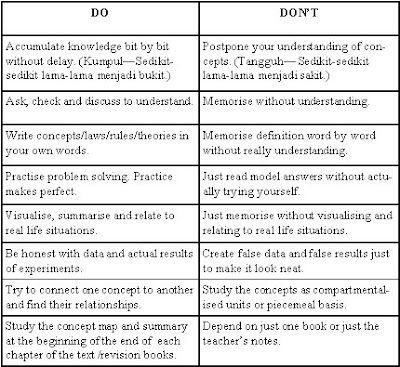
| DO | DON’T |
| Accumulate knowledge bit by bit without delay. (Kumpul—Sedikit-sedikit lama-lama menjadi bukit.) | Postpone your understanding of concepts. (Tangguh— Sedikit-sedikit lama-lama menjadi sakit.) |
| Ask, check and discuss to understand. | Memorise without understanding. |
| Write concepts/laws/rules/theories in your own words. | Memorise definition word by word without really understanding. |
| Practise problem solving. Practice makes perfect. | Just read model answers without actually trying yourself. |
| Visualise, summarise and relate to real life situations. | Just memorise without visualising and relating to real life situations. |
| Be honest with data and actual results of experiments. | Create false data and false results just to make it look neat. |
| Try to connect one concept to another and find their relationships. | Study the concepts as compartmentalised units or piecemeal basis. |
| Study the concept map and summary at the beginning of the end of each chapter of the text /revision books. | Depend on just one book or just the teacher’s notes. |
| DO | DON’T |
| Accumulate knowledge bit by bit without delay. (Kumpul—Sedikit-sedikit lama-lama menjadi bukit.) | Postpone your understanding of concepts. (Tangguh— Sedikit-sedikit lama-lama menjadi sakit.) |
| Ask, check and discuss to understand. | Memorise without understanding. |
| Write concepts/laws/rules/theories in your own words. | Memorise definition word by word without really understanding. |
| Practise problem solving. Practice makes perfect. | Just read model answers without actually trying yourself. |
| Visualise, summarise and relate to real life situations. | Just memorise without visualising and relating to real life situations. |
| Be honest with data and actual results of experiments. | Create false data and false results just to make it look neat. |
| Try to connect one concept to another and find their relationships. | Study the concepts as compartmentalised units or piecemeal basis. |
| Study the concept map and summary at the beginning of the end of each chapter of the text /revision books. | Depend on just one book or just the teacher’s notes. |






